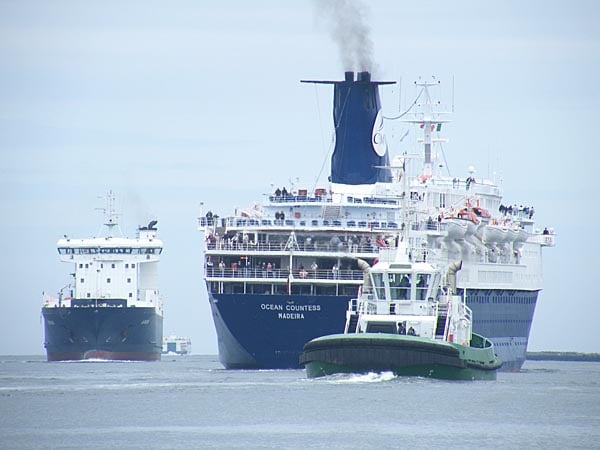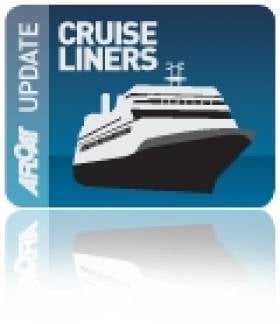Displaying items by tag: Emerald Princess
Cobh Cruiseships Come and Go (Footage)
On Friday the Port of Cork welcomes another large cruiseship in the form of the Emerald Princess which carries 3,592 passengers, nearly 500 more than the Celebrity Eclipse. The 113,000 tonnes vessel is nearly 950-feet long, is 118 wide and draws 28 feet under the waterline. With 19 decks the vessel towers above the oceans and will also do so when alongside Cobh's 350m deepwater berth.
One of the numerous amenities onboard is the CyberGolf link and jogging track which are located high up near the stern. Directly situated below is the Skywalkers Nightclub and for movie-goers, films are shown at an oudoor theatre. The top of the range cabins are the 900 balcony staterooms which offer first class hotel style 24-hour room service.
Dublin and Cork Share Cruise-Calls Bonanza
The ports of Dublin and Cork are scheduled to receive a record 139 cruiseships in total this year, bringing 180,000 visitors and crew. Many more of these cruiseships are due to visit over the next two months and stretching into late Autumn. Between €35-55m is expected to be generated into the Dublin region from high-spend cruise visitors
while a further €5m is predicted for the local economy at Cork, writes Jehan Ashmore.
A notable visitor due to grace Dublin Bay is the return of The World, albeit not strictly a cruiseship but the first custom-built time-share ship. The vessel is to dock in the capital for four-nights from 4-8 August and then sails overnight to Cobh, for two-nights from 9-11 August.
In essence, The World presents an exclusively unique lifestyle experience. Instead of passengers, there are 'residents' who live onboard. Residents of the 43,188 gross tonnes (GT) vessel don't merely occupy a cabin but own large-sized luxurously appointed private apartments that are 'home' complete with balconies.
On 9 August, Silver Cloud docks at Dublin from Oban, Scotland. Measuring 16,927 GT, the vessel may not be the largest with only 315 passengers, but is an ultra-luxury cruiseship, regarded as one of the highest standards in the cruise-sector industry.
Returning to Cork Harbour, Cobh awaits the mighty Independence of the Seas. At 154,407 tonnes, she is the biggest ever cruiseship to dock at any Irish port. With a massive 4,375 passenger capacity, attractions include rock-climbing or surfing-boarding using a special pool. The 'Independence' berths mid-afternoon on 29 August for an overnight call, departing 18.00hrs the next day.
Among smaller cruiseships, the private-motoryacht like, Island Sky of 4,000 tonnes and with 200 passengers, calls to Dublin on 11 August, and may berth upriver close to the new Samual Beckett Bridge.
Those keen on traditional ships, can look forward to the visit of Classic International Cruises Princess Danae, built in 1955. The veteran is due 16 August, and her sister, Princess Daphne is expected 2 September. Unusually the 16,000 tonnes pair were converted from general cargo-ships for a career in cruising.
New cruiseship, Costa Luminosa (92,700 GT) costing US $ 548m makes a second call to Cobh on 3 September and is operated by Costa Cruises.
This is the first time the Italian company has ventured into Irish cruising waters.
Without doubt the largest Dublin caller this season will be Emerald Princess. The giant weighs some 113,000 gross tonnes and at 288m long will certainly provide a spectacle, with lights blaring over a dozen or so decks, during a dusk departure on 14 September.
Also entering service this year, P&O Cruises 116,000 tonnes new Azura, is set to visit Dublin on 23 September and Cork the next day. The Italian built newbuild cost US $ 535m and has a capacity for 3,076 passengers.

Ocean Countess departing Dublin. Photo: Jehan Ashmore/ShipSNAPS
A newcomer to Irish ports is Cruise & Maritime Voyages Ocean Countess which is making round Ireland itineraries with calls at Cobh on 13 August and 12 September. Incidently the 'Countess' was converted into a troopship for the Falkland Islands conflict in 1982.
Jewel of the Seas (90,090 GT) makes a Cobh call on 7 September and exactly a month later returns, marking the last cruise-call to Cork in 2010 while Fred Olsen's Boudicca will be Dublin's last caller on 20 November.
For further information on other visiting cruiseships, please click links:

























































